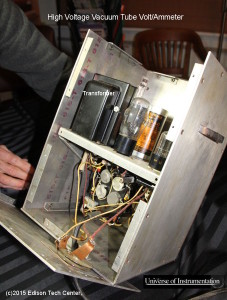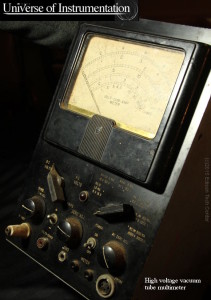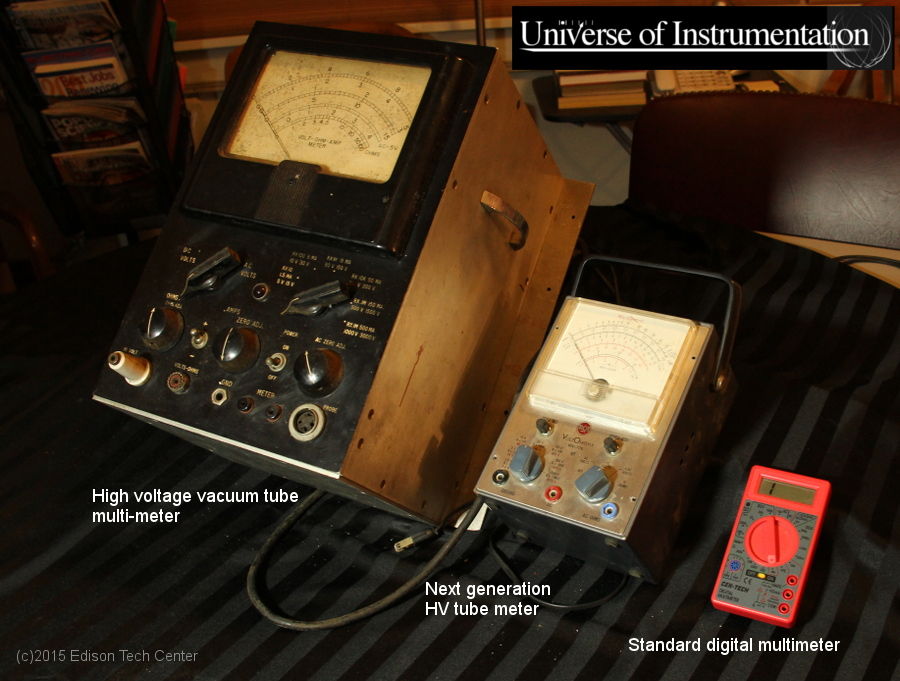AC power obviously poses a challenge to meter design due to its constant changing signal and other phenomena related to AC. To measure the voltage the signal is rectified(converted to DC) by vacuum tubes and can be sent to a moving-coil meter.

Doyle and Chubb developed the Crest Voltmeter which was the beginning of the vacuum tube age in meters. By using “valves” and thermionic emission you can have low and high voltages control/read each other. More on vacuum tubes >
The operation of the Crest Voltmeter is described as: “The condenser terminal or other condenser connected to the high-tension lead takes a charging current at all times proportional to the differential or rate of change of voltage across its terminals. At both the positive and negative maxima of the voltage waves this current is zero and the time integral or area of the current wave between these zero values is a direct measure of the difference between the maximum and minimum voltages.” More >
E.B. Moullin developed the first real vacuum tube voltmeter (1922) thanks to Irving Langmuir’s improvement of the triode vacuum tube.

How vacuum tube voltmeters work:
Voltmeters in the 1920s and beyond put AC current from the grid in the triode vacuum tube. DC current applied to an electrode (hot cathode) would pass through the metal grid and was received on the other side. The amount of electrons passing through the grid would change as the AC current changed the charge values in the metal grid. The max and minimum voltages could be determined by the DC current signal.
 An amplifier stage is usually added to the circuit which can increase the sensitivity of the meter and increases the input impedance. This allows the amount of power drawn by the triode on the main circuit to be reduced to nothing, and therefore the instrument can be highly accurate. Note that vacuum tube voltmeters need time for the cathode to warm up before they can work.
An amplifier stage is usually added to the circuit which can increase the sensitivity of the meter and increases the input impedance. This allows the amount of power drawn by the triode on the main circuit to be reduced to nothing, and therefore the instrument can be highly accurate. Note that vacuum tube voltmeters need time for the cathode to warm up before they can work.
The Vacuum Tube Voltmeter
Advantages:
- Can measure very high and low voltages (with more dynamic range than before)
- Can measure high frequencies as well as utility line frequencies
- Does not disturb the circuit being measured.
- Not subject to magnetic field disturbances
Disadvantages:
- Large and heavy compared to semiconductor devices
- Vacuum tubes burn out and have to be replaced
- Requires a lot of power to warm up vacuum tubes

The quest to measure high voltages using vacuum tubes was something radio pioneers shared in common with the utility industry. Tubes used to measure and transmit radio signal were obviously designed differently but the idea of using thermionic emission with a grid in a triode was key to both pursuits.
Below: see Bill from the Edison show us a few vacuum tube meters of various sizes and ages.

After the vacuum tube solid state technology replaced the vacuum tube, see our next section for semi-conductor based voltmeters.
Sources are found on our credits page.
